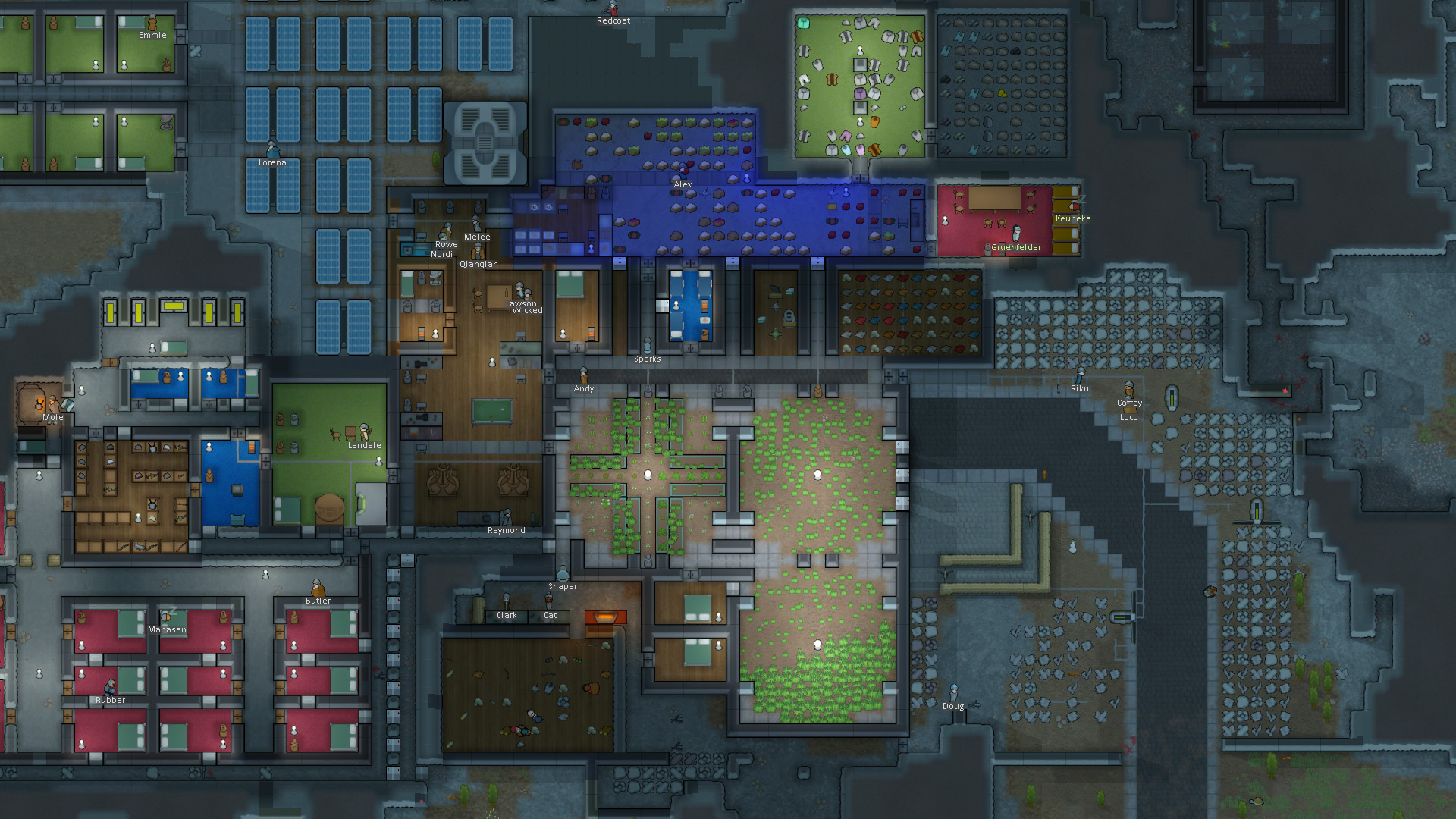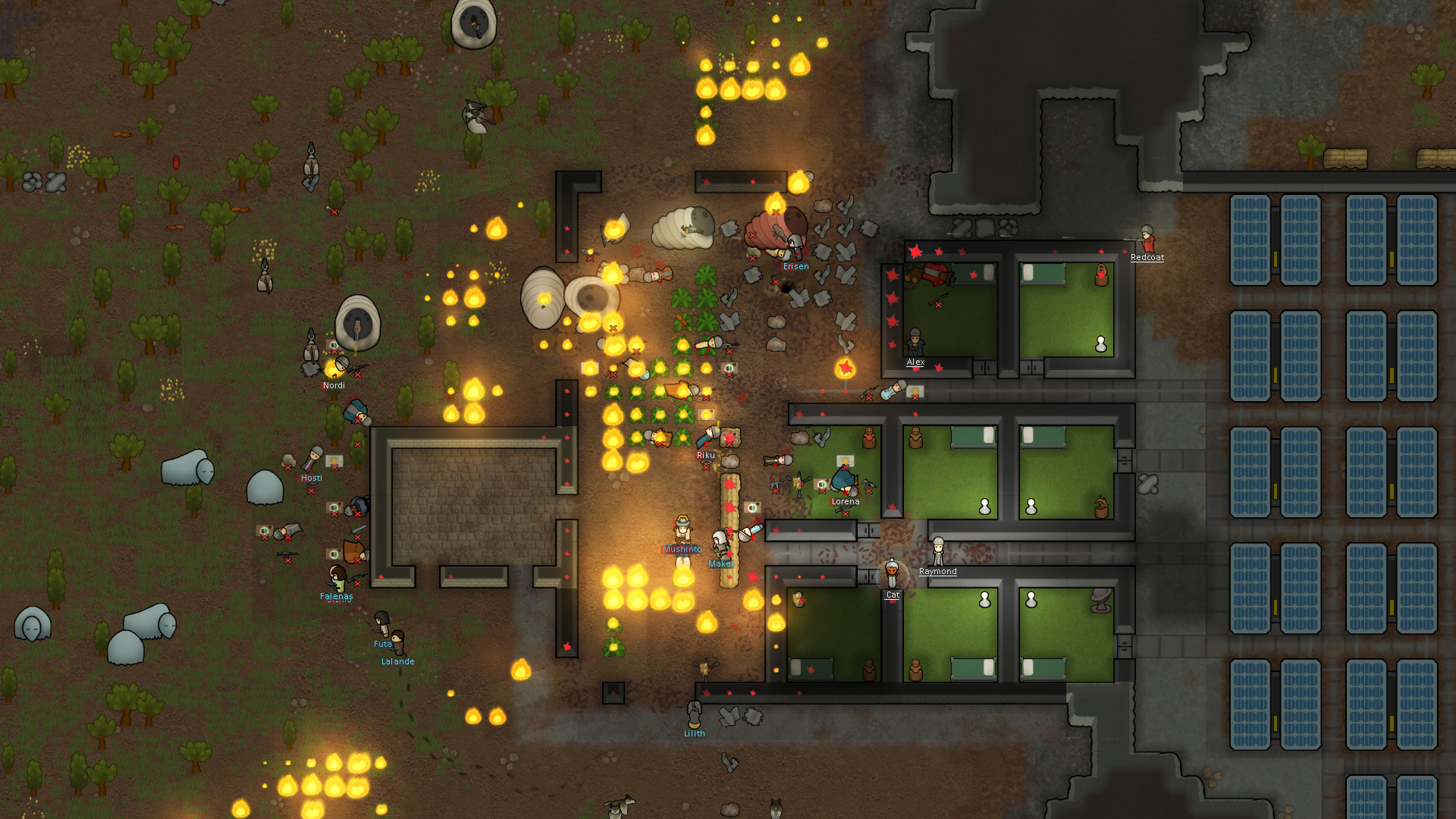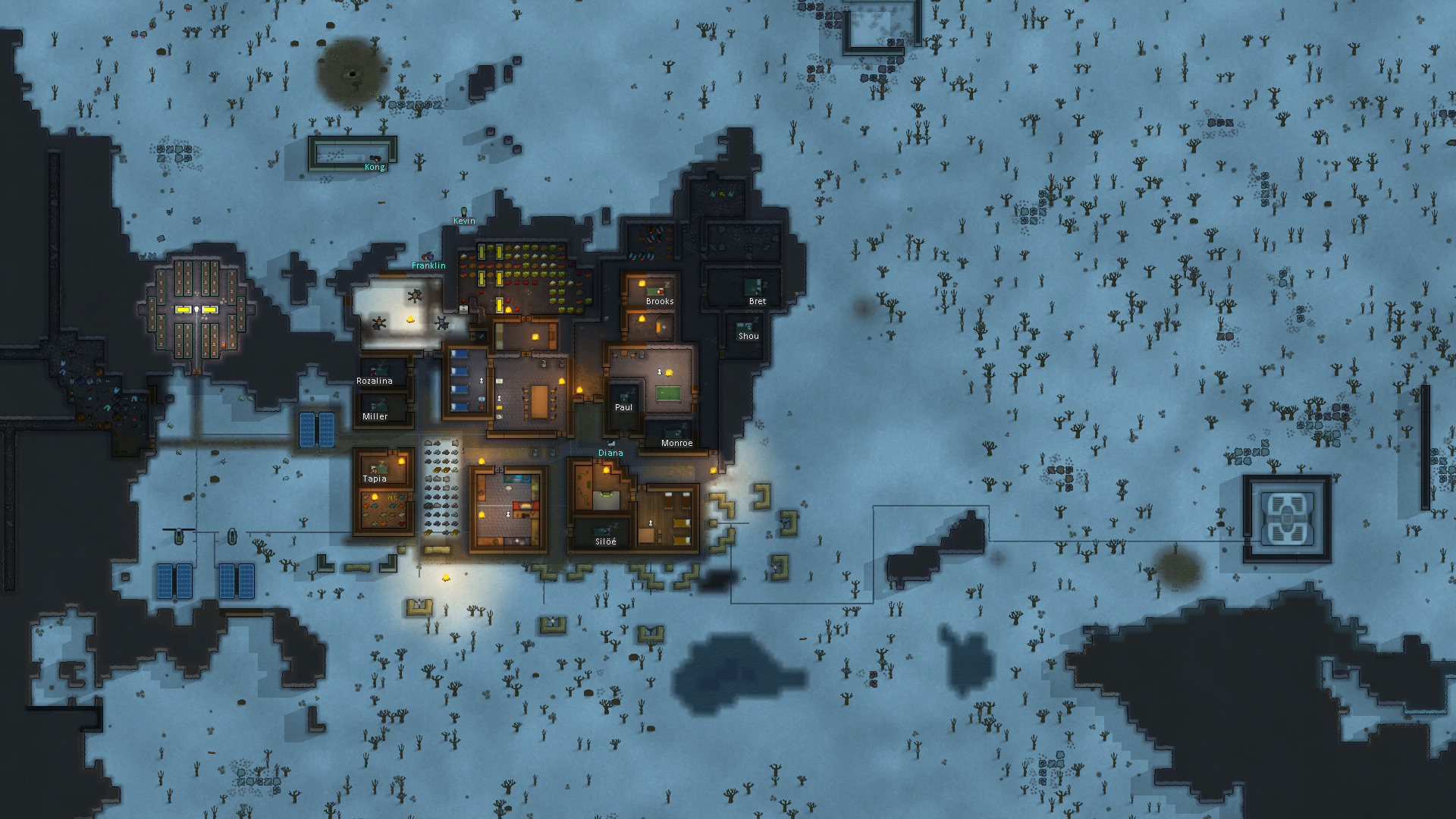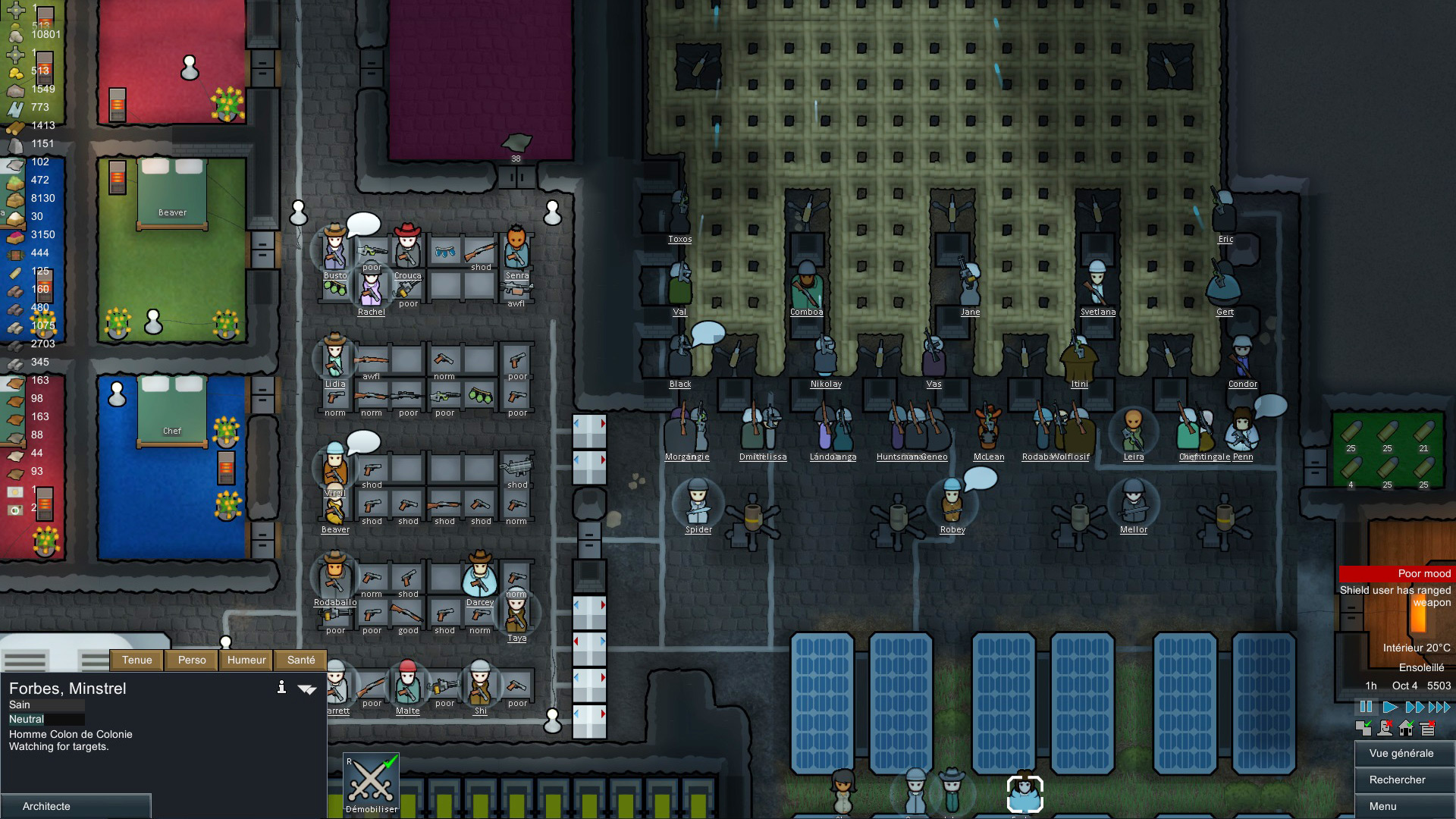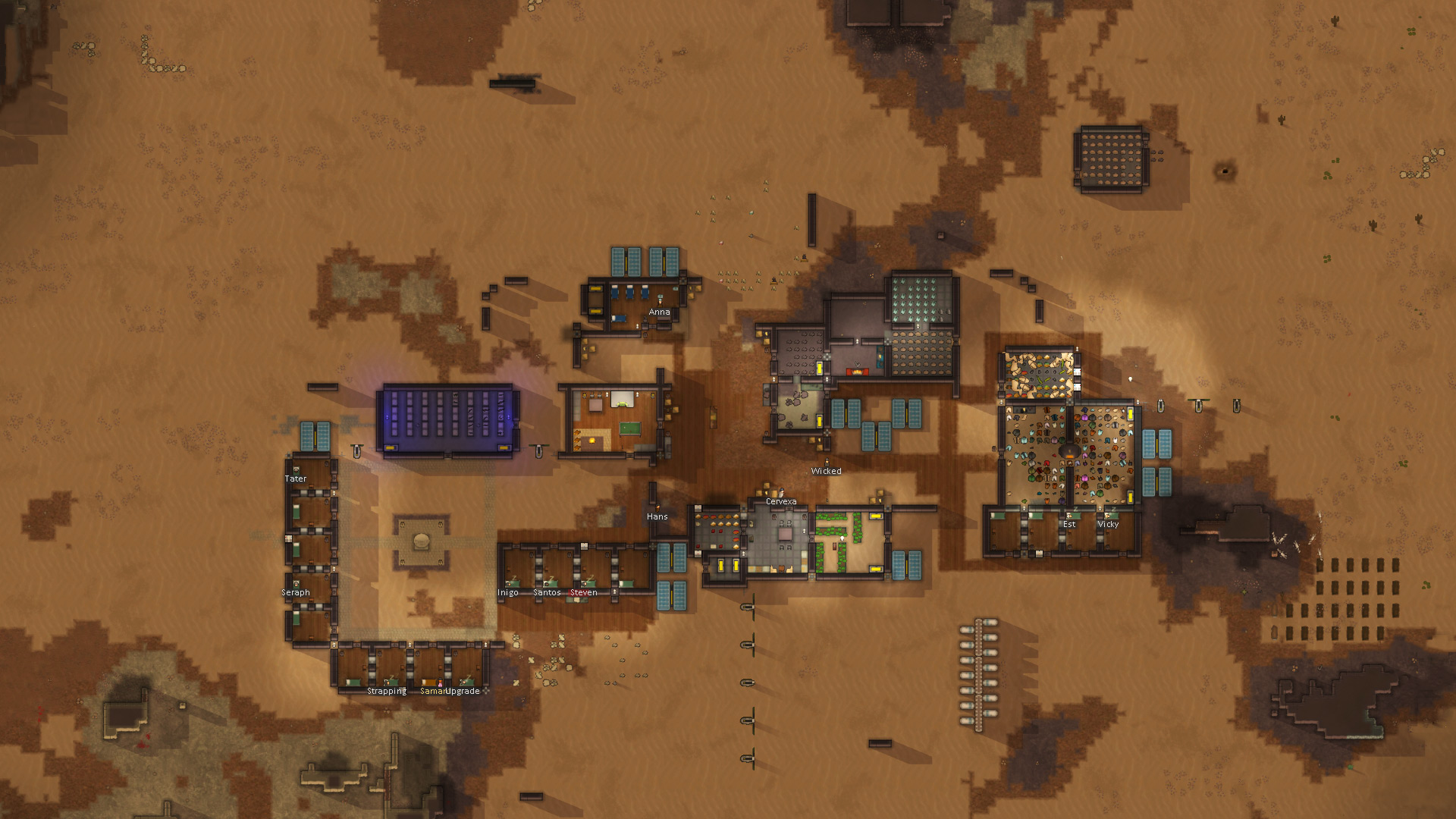You begin with three survivors of a shipwreck on a distant world.
- Manage colonists' moods, needs, wounds, and illnesses.
- Fashion structures, weapons, and apparel from metal, wood, stone, cloth, or futuristic materials.
- Tame and train cute pets, productive farm animals, and deadly attack beasts.
- Watch colonists develop and break relationships with family members, lovers, and spouses.
- Fight pirate raiders, hostile tribes, rampaging animals, giant tunnelling insects and ancient killing machines.
- Trade with passing ships and trade caravans.
- Decorate your colony to make it into a pleasurable space.
- Dig through snow, weather storms, and fight fires.
- Capture refugees or prisoners and turn them to your side or sell them into slavery.
- Discover a new generated world each time you play.
- Build colonies in the desert, jungle, tundra, and more.
- Learn to play easily with the help of an intelligent and unobtrusive AI tutor.
RimWorld is a story generator. It’s designed to co-author tragic, twisted, and triumphant stories about imprisoned pirates, desperate colonists, starvation and survival. It works by controlling the “random” events that the world throws at you. Every thunderstorm, pirate raid, and traveling salesman is a card dealt into your story by the AI Storyteller. There are several storytellers to choose from. Randy Random does crazy stuff, Cassandra Classic goes for rising tension, and Phoebe Friendly just makes good things happen.
Your colonists are not professional settlers – they’re crash-landed survivors from a passenger liner destroyed in orbit. You can end up with a nobleman, an accountant, and a housewife. You’ll acquire more colonists by capturing them in combat and turning them to your side, buying them from slave traders, or taking in refugees. So your colony will always be a motley crew.
Each person’s background is tracked and affects how they play. A nobleman will be great at social skills (recruiting prisoners, negotiating trade prices), but refuse to do physical work. A farm oaf knows how to grow food by long experience, but cannot do research. A nerdy scientist is great at research, but cannot do social tasks at all. A genetically engineered assassin can do nothing but kill – but he does that very well.
Colonists develop - and destroy - relationships. Each has an opinion of the others, which determines whether they'll become lovers, marry, cheat, or fight. Perhaps your two best colonists are happily married - until one of them falls for the dashing surgeon who saved her from a gunshot wound.
The game generates a whole planet from pole to equator. You choose whether to land your crash pods in a cold northern tundra, a parched desert plain, a temperate forest, or a steaming equatorial jungle. Different areas have different animals, plants, diseases, temperatures, rainfall, mineral resources, and terrain. These challenges of surviving in a disease-infested, choking jungle are very different from those in a parched desert wasteland or a frozen tundra with a two-month growing season.
You can tame and train animals. Lovable pets will cheer up sad colonists. Farm animals can be worked, milked, and sheared. Attack beasts can be released upon your enemies. There are many animals - cats, labrador retrievers, grizzly bears, camels, cougars, chinchillas, chickens, and exotic alien-like lifeforms.
People in RimWorld constantly observe their situation and surroundings in order to decide how to feel at any given moment. They respond to hunger and fatigue, witnessing death, disrespectfully unburied corpses, being wounded, being left in darkness, getting packed into cramped environments, sleeping outside or in the same room as others, and many other situations. If they're too stressed, they might lash out or break down.
Wounds, infections, prosthetics, and chronic conditions are tracked on each body part and affect characters' capacities. Eye injuries make it hard to shoot or do surgery. Wounded legs slow people down. Hands, brain, mouth, heart, liver, kidneys, stomach, feet, fingers, toes, and more can all be wounded, diseased, or missing, and all have logical in-game effects. And other species have their own body layouts - take off a deer's leg, and it can still hobble on the other three. Take off a rhino's horn, and it's much less dangerous.
You can repair body parts with prosthetics ranging from primitive to transcendent. A peg leg will get Joe Colonist walking after an unfortunate incident with a rhinoceros, but he'll still be quite slow. Buy an expensive bionic leg from a trader the next year, and Joe becomes a superhuman runner. You can even extract, sell, buy, and transplant internal organs.
And there's much more than that! The game is easy to mod and has an active mod community. Read more at http://rimworldgame.com.
(All non-English translations are made by fans.)
Hey all - Tynan here. This is the first of our Biotech preview blog posts, where we lay out the features of the Biotech expansion, and the thought behind them, in more detail. You can look forward to more posts on the way. (If you missed the Biotech announcement , you probably want to start there. You can wishlist RimWorld - Biotech here .)
Todays preview post covers mechanitor core concepts, mechanoid infrastructure, and labor mechanoids. The next post is in a few days, and will cover combat mechanoids, enemy super-mechanoids, and other mechanitor-related features, and there will be many more after that.
The mechanitor
A mechlink is a new implant that allows a person to form a direct mental link to mechanoids and control them via electromagnetic signals and psychic influence. Someone who has a mechlink is called a mechanitor.
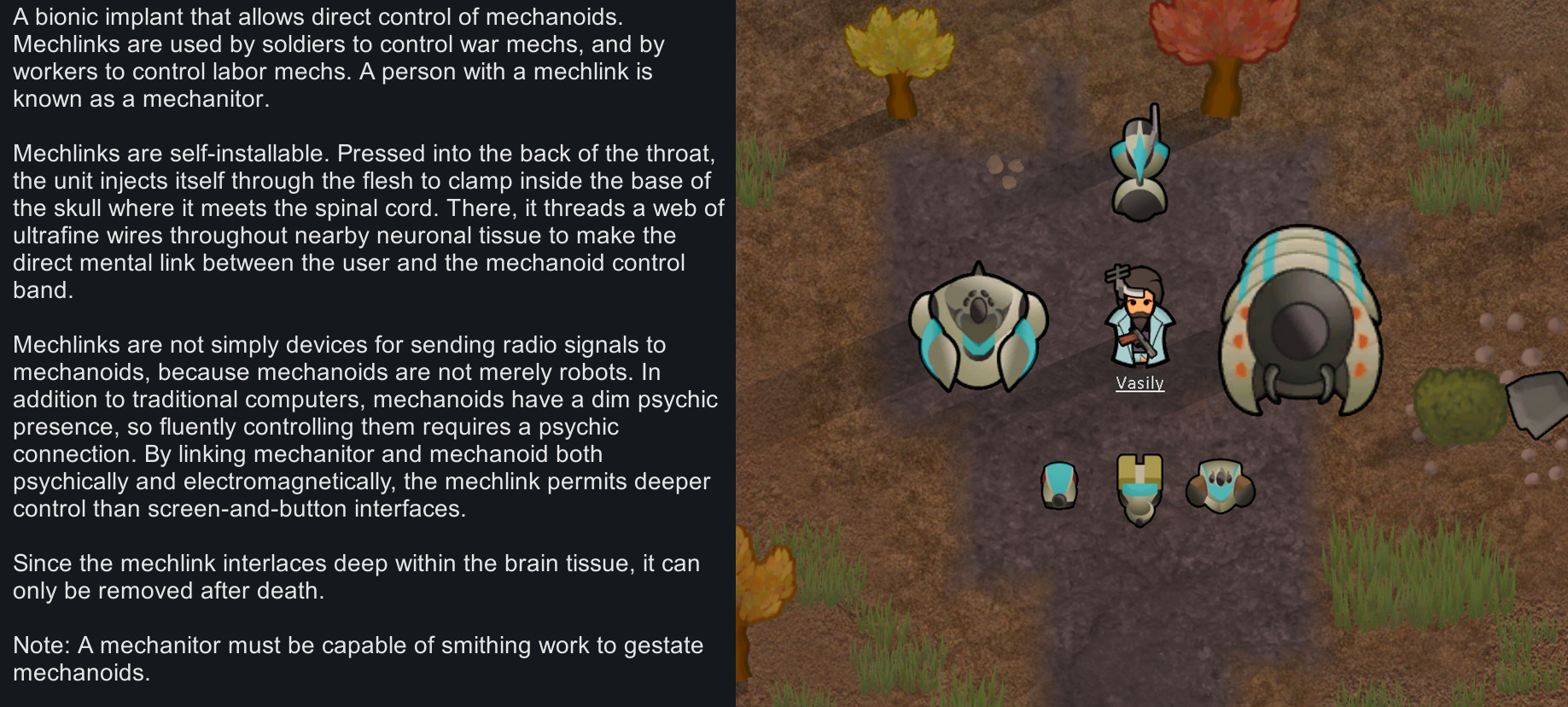
Mechanoids arent controlled independently, but through a human - this design intentionally keeps the mechanoid systems focused on a human being, which is critical to building an emotional story.
Mechanoids can perform in both work and combat. Some mechanoids are workers that will politely harvest crops or haul items as long as their little power cells are charged. Some can work or fight, crushing rock and bone with equal ease. Finally, there are a wide array of pure combat mechanoids with very diverse abilities. Incendiary beam weapons, movable projectile shields, long-range charge lances, blade-covered scythers, flame-spitters and more can be deployed in many combinations to defeat any threat via interlocking tactics.
There are a few ways to become a mechanitor, and all involve looting technology from an ancient dead mechanitor. If you can dig a datacore out of an ancient ruined super-mechanoid, you can use it to call an ancient mechanitors ship to land at your colony and harvest the mechlink from his body. Alternatively, you might be able to learn about an ancient mechanitors command complex, go there, penetrate inside through the security systems and grab the mechlink from him. You can also start the game with the new mechanitor scenario, where you begin the game as a solitary mechanitor with a mechanoid buddy.
Its possible to do a single-person mechanitor run, where one mad scientist type lives alone in a grand base surrounded by walking, semi-thinking machines. Making this possible was a design goal from day one, because exotic play paths are so fun to explore. However, we expect mechanitors to most often live more normally among other colonists, commanding mechanoids to work and fight alongside human allies. If you really want to scale up, it is possible to collect multiple mechlinks and turn several colonists into mechanitors, though this takes a long time.
All our game mechanics interact freely. Its possible for your mechanitor to also be a high noble with the Royalty expansion , a religious prophet with the Ideology expansion , and a deathless blood-drinker with this Biotech expansion , because why not?
Mechanitors start out with the ability to command just a few small mechs. Over time, they can grow a grand swarm. They do this by gaining more bandwidth and control groups:
- Bandwidth determines how many mechs a mechanitor can gestate and control at once. A mechanitor who loses bandwidth will temporarily disconnect from some of their mechanoids. If a mech is left disconnected for too long, it may reconnect with the wild mech hive and leave - or attack.
- Control groups are groups of mechs who can be controlled as a unit. A mechanitor with more control groups can send mechanoids to do more separate tasks at the same time. A more advanced mechanitor can have combat mechs patrolling a colony, labor mechs toiling in the field, and bodyguard mechs escorting them around, all at the same time.
Mechanoid challenges
A basic game design principle is to push things as far as they can go without breaking the game - that means make tools more powerful, enemies more dangerous, changes more overwhelming than seems safe at first. The idea is to ensure youre exploring the full range of experience thats possible in your game systems.
So we wanted mechanoids to be very powerful in order to create more extreme situations and distinct playstyles. The more impact they have, the more they can transform your game. However, in order to not unbalance the game, this meant that they needed to come with serious challenges as well. But what?
Existing costs in the game are things like consuming food, chemfuel, or steel over time. But simply making mechanoids consume resources wouldnt feel transformative, and wouldnt substantially alter gameplay since the mechanoids can pay for themselves by producing the resources they consume. The collect/spend loop is too simple and has almost no side-effects on the world, story, or characters.
So we decided to emphasize two new challenges that would come with mechanoids: Infrastructure and pollution. We cover infrastructure below - A future post will cover pollution, its causes, consequences, aspects, uses, and solutions.
Mechanoid infrastructure
Mechanoids require heavy infrastructure that takes up a lot of space and burns a lot of electricity. Big sections of your colony can turn into mechanoid maintenance, production, and control centers. Youll feel your plucky wooden village transforming into a grand integrated machine of generators, chargers, control nodes, and gestators. Your base will tend to grow large with a lot of mechanoids, and have a lot of things moving and consuming.

Each mechanoid must contain a mechanoid brain known as a subcore (short for subpersona core - the psychic substrate on which a dim, sub-human-level intelligence can be hosted). There are several tiers of subcores, with more advanced mechanoids requiring more advanced subcores.
Basic-level subcores can be produced by a mechanitor with just some resources and time at the subcore encoder.
More advanced subcores require scanning the psychic pattern from human minds. A person can be placed in a subcore softscanner and scanned to produce a subcore. This causes temporary mental effects but is ultimately harmless.
The most advanced mechanoids need extremely high-fidelity psychic patterns to work, and these can only be readily produced using the subcore ripscanner, which scans the brain quickly at ultra-high energy, destroying it in the process.
Once a subcore and resources are ready, mechanoids can be produced in mech gestators. Instead of being built like normal machines, mechanoids are gestated in a mechanite-rich solution that accretes the mechanoid molecule-by-molecule in a quasi-biological process. Gestation takes time, electricity, resources, and occasional guidance by your mechanitor.
Only a mechanitor can guide the gestation process, since it requires a psychic link to the growing mechanoid. As always, everything about the mechanoids links back to the human whom they serve.
The gestator can also resurrect some types of mechanoids. This makes your mechanoids more expendable in combat, which makes using them in combat give more distinct strategies compared to using human fighters.
There are several sizes of gestators. Small gestators are used for smaller mechs, while larger gestators are needed to produce ultra-heavy war machines. Little mechs gestate quickly, while big bosses take a long time to grow.
Mechanoids consume their onboard energy supply over time and must recharge at mech rechargers. Mechanoids will automatically seek out available rechargers so they dont run out of energy. If they do run out of energy theyll enter a self-shutdown state and recover energy very slowly - its much better to have a mech recharger available to keep your mechs working hard. There are several sizes of mech rechargers appropriate to different tiers of mechanoids. They consume a lot of electricity, and produce pollution as well - the characteristic cost of mechanoids.
Band nodes are signal amplifiers that can increase a mechanitors total bandwidth. They can be quickly tuned to a specific mechanitor. However, returning a band node to a different mechanitor is a complex task and requires a long time. There is no limit to how many band nodes a mechanitor can build, so a mechanitor can have a huge swarm, though it will require heavy infrastructure to control.
Mech boosters are enhancer buildings that boost the speed and work ability of mechanoids nearby. Great for powering up mechanoid-based factories.
Mech signallers are a set of single-use structures that can be used by a mechanitor to call in fearsome super-mechanoid enemies to attack you. You need to call these enemies so you can loot their corpses for special high-tech mechanoid chips. These chips are core to the mechanitors progression since they are needed to advance to the next tier of mechanoid technology. This structure of choose your enemy and be ready is a little bit new for RimWorld, and creates a new kind of self-directed game pace for the player (as opposed to being blindsided by raids at any time).
Well explore these super-mechanoids in more detail in the next blog post.
Labor mechs
Labor mechs can perform a variety of work tasks (but not absolutely everything - some things still need a human touch). Some are plucky little worker bois who are best kept away from danger, while others are hulking crusher machines that tank damage with ease.

Paramedic mechs are designed to aid in emergency situations. They can rescue the wounded, fight fires and even perform surgery. The paramedic has a built-in jump launcher for quickly getting into and out of emergency situations, making it excellent for extracting downed colonists from battle. It also has a built-in firefoam popper which it can use to extinguish fires. It also has basic medical skills - it can tend the wounded and sick, and even perform surgery when a skilled human isnt available.
Lifters are there to move things where they need to go. Theyre small, weak, pretty easy to get and always useful. They will haul a corpse to a grave or rearm a turret. They lack a real weapon.
Constructoids can perform an array of construction tasks, from building roofs to repairing buildings and even hauling resources to blueprints. The constructoid is equipped with a small slug gun for light defense and built-in cutting blades, but is not a good frontline fighter.
Agrihands are small mechanoids designed to sow and harvest crops and can perform a blunt melee attack.

Cleansweepers are light mechanoids that clean filth and do blunt melee attacks.
Fabricors will craft all manner of manufactured objects at your work benches (though they cant do the same quality of work as a skilled human). Like the constructoid, the fabricor has a small slug gun.
Tunnelers are massive, heavily-armored mechs equipped with gigantic crusher claws. The tunneler can dig tunnels and mine resources tirelessly. In combat, it is slow but its very strong armor makes it an excellent tank for absorbing enemy fire while your other fighters deal damage. The tunneler has a small built-in smokepop pack which can activate to spread smoke and shield itself from incoming fire. It also has a shield pack that recharges over time. Its weakness is that each time it takes damage, it slows for a few seconds - this means that when tunnelers attack you, even if you cant kill them quickly, you can intelligently kite them by falling back from your position to escape the blocking smoke, maintain distance and slowly whittle the tunnelers down. (More on mech combat in the next post.)
Thats it for today! You can wishlist Biotech on the Steam store page and please join the discussion of this post on Reddit .
Were planning on several of these blog posts, so theres no shortage of more Biotech info on the way. Cheers for now, thanks for reading.
-Ty
Minimum Setup
- Processor: Core 2 DuoMemory: 4 GB RAM
- Memory: 4 GB RAM
- Graphics: Intel HD Graphics 4000 or other shader model 4.0
- Storage: 1 GB available space
[ 6338 ]
[ 5801 ]
[ 1933 ]
[ 2282 ]

